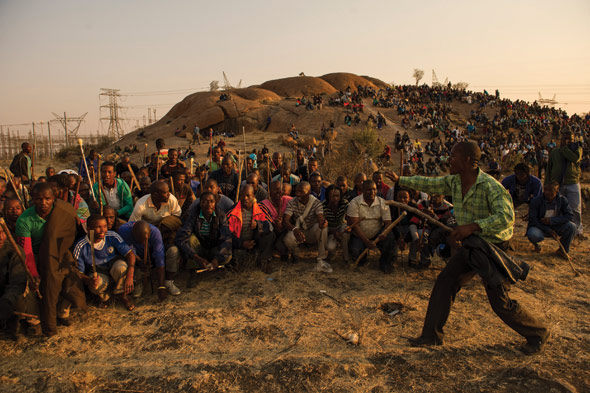Marikana: Three years after the massacre
17 August 2015 | Story by Newsroom
The UCT Marikana Forum has commemorated each anniversary of the massacre, and will do so again from 18 to 20 August, with a movie screening, panel discussion and memorial lecture, to be held at the Centre for African Studies gallery. In this opinion piece, Assoc Prof Andrew Nash, Department of Political Studies, reflects on UCT's place in the aftermath.
The cover-up of the Marikana massacre of 16 August 2012 began even before the massacre itself, with Cyril Ramaphosa's emails to cabinet ministers, calling on them to treat the strike at Lonmin's platinum mine as "dastardly criminal" action, requiring "concomitant" action.
In the first year after the massacre, South Africa's ruling elites and institutions did everything they could to ignore or trivialise the massacre, or blame it on the victims.
The police arrested surviving mineworkers on charges of common-purpose murder; President Jacob Zuma described it as "not a time for pointing fingers"; the ANC and its allies slandered the dead as muti-crazed criminals; COSATU pretended the massacre had not happened; media and educational institutions, including UCT, either ignored it or treated it as a "tragedy," as if it was an earthquake or a flood.
Working-class communities have identified with the victims of the massacre, seeing their own experience in the mirror of Marikana and giving the name of Marikana to informal settlements across South Africa. They have not forgotten it, and continue to draw lessons from it.
The Marikana events to be held this week commemorate the slain mineworkers, call for justice to be done, and try to clarify the ongoing significance of the massacre.
It is a fork in the road which leads either to a new class apartheid in South Africa, with rights for a privileged minority and the rule of the gun for the majority, or to a truly democratic society, in which priority is given to the needs of all rather than luxuries for the few.
The release of the Farlam Commission's report is the latest installment in the cover-up of the massacre, with extraordinary legal contortions enabling them to find no one responsible for it. To get a rough sense of the travesty of justice this requires, imagine two groups are involved in a "tragic incident" in which many die violently. The victims are found not to have done all they could to prevent it; it cannot be definitively proven that the perpetrators were entirely responsible for it.
Although the Farlam Commission has turned a consistently blind eye to the evidence before it of a government willing to murder those of its citizens fighting for a decent life, its report implicates the government and police on various issues. These were brushed over in Zuma's announcement of the commission's findings, with no word of objection raised by the commission itself.
Three years after the massacre, we have no choice but to respond – through our actions, words or silence – to the unresolved questions it raises in every sphere of South African life.
Much has been said about UCT's links with the mining industry during the campaign to bring down Rhodes' statue. Is UCT still benefitting from the exploitation and murder of black mineworkers?
Is it taking Lonmin's money, along with that of Rhodes? If so, will it give that money back to the mineworkers for whom Lonmin has promised, and still not built, decent housing? Will debates of the future of the UCT syllabus ask how our teaching and learning can contribute to creating a society in which workers are no longer killed in the name of profit?
Story by Andrew Nash. Photo by Greg Marinovich.
 This work is licensed under a Creative Commons Attribution-NoDerivatives 4.0 International License.
This work is licensed under a Creative Commons Attribution-NoDerivatives 4.0 International License.
Please view the republishing articles page for more information.










